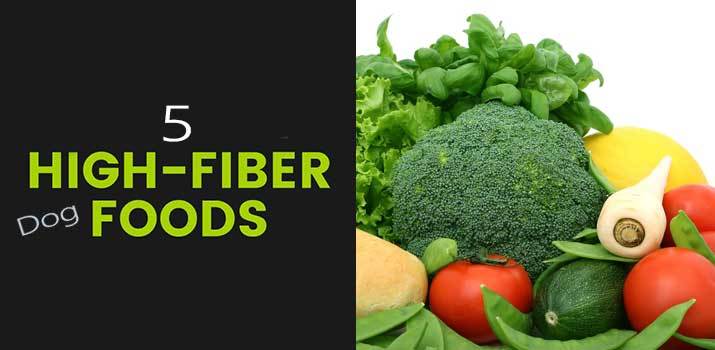
The benefits of a high-fiber diet for humans are very well documented. In fact, it's not hard to see meals and snacks advertising their high fiber content all over your grocery store. If humans can make a conscious effort to improve their overall digestive health, why not do the same for dogs?
Typically, fiber is not what most owners think about when they're choosing their canine companion's kibble.
Unfortunately, this lack of foresight often leads to upset stomachs, anal gland issues and less-than-ideal messes around the home.
Luckily, there are many great high-fiber dog foods out there to choose from.
Most of these healthy foods aren't specifically labeled as "high-fiber." or for anal gland problems.
As a result, you're going to have to scrutinize the ingredient's list and do some research to get a better understanding of what these foods can do for your dog.
Here's a great selection of options to improve your dogs digestive health
Top 5 Best High-Fiber Dog Foods
#1. Blue Buffalo Wilderness High Protein Grain Free, Natural Adult Dry Dog Food
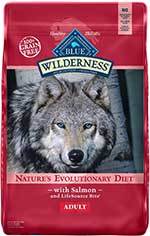
This dry kibble from Blue Buffalo Wilderness is a great option if your dog is relatively healthy but is dealing with mild anal gland issues.
The recipe contains 6 percent fiber. It includes great ingredients like alfalfa, tomato pomace, dried chicory root, and flaxseed. What you won't find is simple carbs, unnecessary fillers, and grains.
Overall, the dog food is quite a healthy option. It has 34 percent protein, most of which comes from salmon. Of course, Blue Buffalo also threw in their signature LifeSource bits, which contain antioxidants, vitamins, and nutrients.
2. Earthborn Holistic Coastal Catch Grain-Free Dry Dog Food
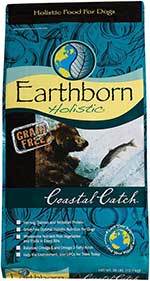
If your dog suffers from allergies, finding a high-fiber dog food to help with anal gland issues can be tough due to the unique nature of the ingredients. Luckily, Earthborn Holistic has a great grain-free formula.
Its fiber content comes from all-natural ingredients. You'll find fruits and vegetables, such as carrots, apples, and spinach. The fiber makes up about 4 percent of the recipe. When it comes to protein, this particular recipe utilizes a collection of fish.
It has herring meal, salmon meal, and Pacific whiting meal. There's also flaxseed for omega fatty acids, blueberries for antioxidants, and much more.
3. Natural Balance Limited Ingredient Diets Dry Dog Food

Another great option for allergy sufferers is the Natural Balance Limited Ingredients formula. As the name suggests, it has only the essentials. There are no grains, unwanted fillers, or chemical preservatives.
Everything is natural and healthy. It has a higher fiber content than most traditional foods at 5 percent. Most of this fiber comes healthy sweet potatoes.
Other great ingredients include salmon for protein, salmon oil for omega fatty acids, and plenty of minerals for healthy joints and bones.
Overall, the ingredients list is pretty small, allowing you to know exactly what your pup is consuming.
4. Taste of The Wild Grain-Free Premium High Protein Dry Dog Food
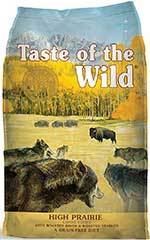
The Taste of the Wild High Prairie dog food is a great dog food option across the board. It's typically chosen by dog owners wanting to give their pup a natural diet that's rich in protein.
However, it also does pretty well in terms of fiber. It contains about 4 percent, none of it coming from grains that could potentially cause stomach issues. Instead, the fiber is derived from sweet potatoes, tomato pomace, and chicory root.
As always, Taste of the Wild also added plenty of protein sources. The 32 percent protein content is made up of lamb, venison, beef, and buffalo, among other things.
5. Wellness Complete Health Natural Dry Healthy Weight Dog Food
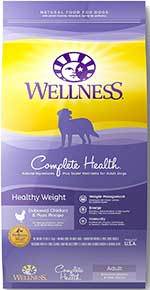
From Wellness Natural Pet Food is the Complete Health kibble formula. It's specifically designed to combat weight issues, helping your dog stay healthy throughout their life.
It's made up of 4 percent fiber. The fiber sources are plentiful. You'll find flaxseed, oatmeal, ground brown rice, ground barley, tomato pomace, apples, and much more. In fact, most of the plant-based ingredients within this recipe also do double-duty as an excellent source of fiber.
It has no corn, wheat, soy, or artificial additives, making it easy for your dog to digest.
High-Fiber Food Supplement
The Missing Link - Original All Natural Omega Superfood Supplements
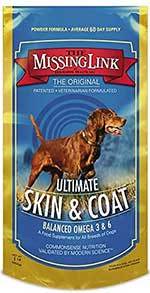
This dog food supplement from The Missing Link is a great way to introduce more fiber into your dog's diet without switching foods completely. While it is advertised as a product for your pup's skin and coat, it very rich in fiber.
Most of the recipe contains high-fiber ingredients. You'll find flaxseed, sunflower seeds, dried alfalfa, carrot, dried barley, and kelp. All of these ingredients can benefit your dog's digestive system while also providing them with a boost of omega fatty acids.
The power form makes it very easy to feed to this supplement to your dog. Simply sprinkle the supplement over their kibble.
What is Fiber and What Does It Do?
Before we get into the benefits of a high-fiber diet for your dog, it's good to understand what fiber actually is. Essentially, fiber is a type of carbohydrate that's not affected by the enzymes in your dog's digestive tract.
As a result, the fiber is able to pass through your pup's system virtually intact. While this may not seem like a good trait to have in dog food, it's actually very advantageous.
You see, it's this ability to pass through the system without being absorbed that makes fiber so healthy. Because it's not digested in the same way as other carbohydrates or protein are, it can affect your dog's body in other ways.
It can actually absorb other nutrients, introduce new types of beneficial bacteria in the colon, and much more.
Fiber can be found in a number of different ingredients. However, it's most prevalent in fruits, vegetables, and other leafy greens.
Types of Fiber
There are two distinct types of dietary fiber. There's soluble fiber, which absorbs a lot of water as it passes through the digestive tract, and insoluble fiber, which absorbs very little water.
Both can be a healthy choice for your dog. However, the preferred type of fiber is soluble. Soluble has the most effect on your pup's body and is much easier to pass.
How a High-Fiber Dog Food Can Help Your Dog
As we mentioned earlier, fiber can provide your dog with a number of different health benefits. Dogs that consume a high-fiber diet usually have a better immune system and have a smaller chance of experiencing health issues.
Here are some of the most noteworthy things that fiber can do for your dog.
Prevent Digestive Issues
No dog owner likes to deal with the mess involved with canine digestive issues. Even more importantly, your dog hates the way stomach discomfort feels.
Fiber can help prevent stomach problems from occurring. If your dog is dealing with constipation, there's a lack of moisture that's making it difficult for them to do their business.

Fiber can alleviate the symptoms by introducing more water into their digestive system. On the other side of things, diarrhea is a result of having too much water. A good amount of soluble fiber will draw moisture out to fix that issue right up.
By consuming a regular high-fiber diet, your dog may experience fewer stomach issues. They'll be more regular. Your dog's stool will be healthy, consistent, and comfortable to pass.
Another great perk of fiber is that it tends to make excrement a bit firmer and bulkier. As a result, it scrubs the walls of your dog's colon as it is passed. This helps to keep things clean and healthy.
Reduce the Chances of Diabetes
High-fiber foods are often recommended to humans that are at a higher risk of developing diabetes. The same thing applies to canines. Dogs with diabetes have a malfunctioning pancreas that doesn't produce enough insulin. Insulin is crucial for regulating blood sugar levels.
Foods that are high in fiber can help keep blood sugar levels under control by slowing down the rate in which sugar is absorbed into the body. While there are a number of other factors that can affect a dog's susceptibility to diabetes, regular fiber intake has been shown to reduce the risks quite a bit.
Maintain a Healthy Weight
Obesity is a very real problem with domesticated dogs. Some breeds are more prone to weight gain than others, but it's something that can affect all dogs. Fiber is an ingredient that's typically used in dog foods that are designed to promote weight loss.
This is because fiber helps your dog feel full without the added calories. While low-calorie foods can certainly help with a weight-loss plan, your dog will probably be affected by hunger.
Fiber takes up a lot of space in your dog's stomach. Not only that, but it's not digested. Because it stays in your dog's body for a longer period of time, they won't feel hungry.
Fiber and Your Dog's Anal Glands
So, let's talk about anal glands. It's not something dog owners like to discuss, nor is something they like to deal with. However, it's important to understand what anal gland problems are and how to deal with them.
All canines have two glands on the lower sides of their anus.
These glands fill up with a thick substance that's very pungent. Usually, these glands are emptied out each time your dog goes outside to relieve themselves. However, they can also get clogged up.
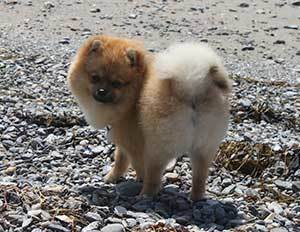
This is most common with smaller dogs, but it can affect larger breeds as well. When the glands become clogged, the substance inside can't escape.
With that being said, that doesn't stop the fluid from accumulating. What results is swollen anal glands that are very painful for your dog.
One tell-tale sign of anal gland problems is excessive licking and scooting on the ground. Once the glands get swollen, the only thing you can do to provide relief is to manually express them.
Needless to say, that process is not fun for you or your dog. It's also a good idea to take your dog to a vet for an examination, as anal gland problems can become chronic with a bad diet.
Fiber works to alleviate clogged anal glands by changing your dog's stool. As mentioned earlier, fiber makes poop firm and bulky. When your dog does their business, more pressure is applied to the glands, making it easier to release the contents naturally.
What to Look for in a High-Fiber Dog Food for Anal Gland Issues.
It's important to remember that your dog's body is a lot different than your own. Their digestive tracts are significantly shorter than that of a human's. They're also less capable of digesting certain types of food.
As a result, not any old fiber will do. You need to find a dog food with beneficial fiber that they can pass without any issues.
Fiber Sources
Fiber is present in most carbohydrate sources. However, simple carbs can do more harm than good. Ingredients like corn, wheat, soy, and other grains are notorious for wreaking havoc on a dog's digestive system. This is because they're used as fillers that don't provide much in terms of nutritional content.
They're also very difficult for your dog to digest. These ingredients happen to be very high in fiber. As a result, they're often used in cheaper dog foods to fluff up the fiber content.
Instead of those unwanted fillers, you should keep your eyes peeled for other sources. Flaxseed, beet pulp, and numerous legumes are all healthy sources. Fruits and vegetables like carrots, apples, pumpkins, and sweet potatoes are also great.
Not only do they provide plenty of fiber, but they come with the added boost of vitamins and nutrients. Leafy greens such as alfalfa and spinach are also good ingredients to look out for.
Overall Fiber Content
Most commercially available dog foods have fiber content as low as 2 percent. High-fiber options may have upwards of 10 percent. If you want to take advantage of the health benefits that fiber can provide to your dog, aim for a fiber percentage of 4 or 5 percent.
Even just a small bump up to 5 percent is enough to see great results. You should not attempt to go beyond 10 percent, as it could lead to some unwanted side-effects.
Fiber Supplements
You don't have to ditch your dog's favorite food just to provide them with more fiber. Fiber supplements are available to bridge the gap. They often come in tablet form, making it easy to introduce into their normal meals.
Alternatively, you can mix in some natural ingredients to their food. Just add some cooked sweet potatoes or pumpkin puree. These ingredients are relatively affordable and very easy to mix with dry kibble.
Before You Make the Switch...
As with any other diet change, a sudden increase in fiber can result in some initial discomfort. There's a fine line between providing a healthy amount of fiber to your dog's diet and providing too much.
Consult With Your Vet
You should always keep your vet in the loop when it comes to dietary changes for your pooch. Your veterinarian can provide some insight into the types of fiber your dog needs and how much of it can benefit them.
If your dog is experiencing chronic digestive problems, they may also be able to give you a better idea of the underlying cause and any remedies that could be used to resolve it.
Possible Side Effects
Some dogs experience even more constipation and diarrhea when more fiber is introduced into their diet. This is because their bodies aren't used to this sudden influx of non-digestible matter.
They may start to suffer from colitis, which is inflammation of the colon. Depending on how much fiber they eat, they could also develop gas problems and bloat.
The key to avoiding this is to find the right amount. Again, consult with your vet for assistance. They can help you determine what's good for your dog's unique needs.
Make the Adjustment Over Time
Another way to avoid side-effects is to introduce the new high-fiber food slowly over time. This gives your dog's body enough time to adjust to the changes. Instead of having to deal with the fiber all at once, your pup's digestive tract can adapt over time.
You can complete the switch over the course of two or three weeks. Start out by swapping out only a third of their old food with the new variety. Keep this up for about a week and look out for any signs of digestive discomfort.
If they have no problems during the first week, start swapping out two-thirds of their meal. By the third week, you should be able to transition to the new food completely.
Conclusion
With all the great benefits that high-fiber dog foods can provide, your dog has nothing to lose and a lot to gain.
As long as you stick with high-quality dog food products, consult with your vet about appropriate fiber levels, and transition slowly to give their systems time to adjust, you should have no problems making the switch.
Also Read:

